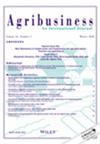谁愿意为室内农业生产的绿叶菜支付溢价?以美国消费者为对象的比较选择实验
IF 2.1
3区 经济学
Q2 AGRICULTURAL ECONOMICS & POLICY
引用次数: 0
摘要
室内农业(IA)通过严格控制生长环境、提高水和土地资源的利用效率、减少农药施用以及提高质量特性,为更可持续地生产绿叶菜提供了一条途径。然而,采用这种生产方式能否在商业上取得成功,取决于该技术能否得到消费者的广泛认可,以及消费者是否会为该技术所带来的质量提升溢价。本文描述了美国消费者对绿叶菜的偏好,报告了绿叶菜属性的正 WTP,并估计了消费者对 IA 的态度如何影响他们对绿叶菜的选择。研究结果来自 2021 年对 2000 多名美国绿叶菜消费者进行的在线调查。受访者面对的是一个模拟购买绿叶农产品的假设离散选择实验(DCE)。离散选择实验中的替代品因生产系统(IA、田间耕作或温室)和质量水平(口感、新鲜度、营养水平和食品安全)而异。估算结果表明,消费者对绿叶蔬菜属性的偏好存在明显的异质性,并有助于将消费者划分为三个基于偏好的群体:"质量追求者"、"价格敏感者 "和 "专注实用者"。消费者对生产方式的偏好差异明显大于对质量特性的偏好差异,这表明消费者对生产方式的偏好刚刚开始。结果表明,大多数美国消费者对 IA 持积极态度;然而,不同消费者群体的 WTP 估计值差异很大[经济学引文:D12, D13]。本文章由计算机程序翻译,如有差异,请以英文原文为准。
Who is willing to pay a premium for leafy greens produced by indoor agriculture? A comparative choice experiment with US consumers
Indoor agriculture (IA) presents a pathway to producing leafy greens more sustainably by strictly controlling the growing environment, increasing the efficiency of water and land resources use, reducing pesticide application, and enhancing quality characteristics. However, the commercial success of adopting this production method depends on the technology's widespread consumer acceptance paired with a price premium for the improved quality it provides. This paper characterizes American consumer preferences for leafy greens, reports a positive WTP for leafy green attributes, and estimates how consumer attitudes toward IA affect their leafy green choices. The findings are drawn from an online survey of over 2000 US leafy green consumers conducted in 2021. The respondents faced a hypothetical discrete choice experiment (DCE) designed to simulate purchasing leafy green produce. The alternatives presented in the DCE varied over production systems (IA, field farming, or greenhouses) and quality levels (taste, freshness, nutrient level, and food safety). Estimates identify significant preference heterogeneity for leafy green attributes and facilitate classifying consumers into three preference-based groups: “Quality Seekers,” “Price Conscious,” and “Focused Practicals.” Preference variation is significantly greater for production methods than quality characteristics, indicating nascent production method preferences. Results suggest most US consumers view IA positively; however, WTP estimates vary significantly between consumer segments [EconLit Citations: D12, D13].
求助全文
通过发布文献求助,成功后即可免费获取论文全文。
去求助
来源期刊

Agribusiness
农林科学-食品科技
CiteScore
5.50
自引率
6.20%
发文量
58
审稿时长
6 months
期刊介绍:
Agribusiness: An International Journal publishes research that improves our understanding of how food systems work, how they are evolving, and how public and/or private actions affect the performance of the global agro-industrial complex. The journal focuses on the application of economic analysis to the organization and performance of firms and markets in industrial food systems. Subject matter areas include supply and demand analysis, industrial organization analysis, price and trade analysis, marketing, finance, and public policy analysis. International, cross-country comparative, and within-country studies are welcome. To facilitate research the journal’s Forum section, on an intermittent basis, offers commentary and reports on business policy issues.
 求助内容:
求助内容: 应助结果提醒方式:
应助结果提醒方式:


